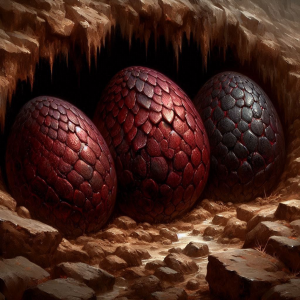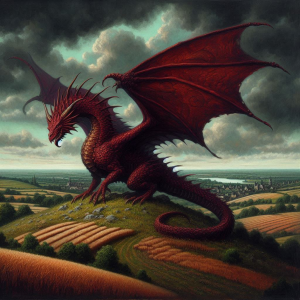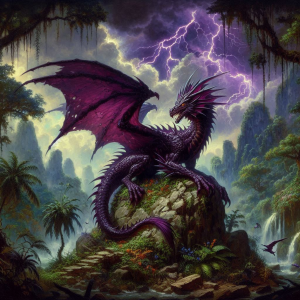Dragons
|
| Class | Dragon |
| Rarity | Epic |
| Size | Huge / Gargantuan |
| Stats |
See below HP See below Strength See below Defense See below Agility See below Intelligence |
Introduction
Dragons are large reptilian creatures who have come to Eden far before intelligent life tamed the wild lands of the continent. They are one of the last remaining primordial creatures that still roam the continent and have managed to stave off extinction as one of the few of their age. They come in a handful of varieties, that being the large fire-breathing dragons from the west of Eden, the large frost-breathing dragons of the Glade and far North of Eden, and lastly the enchantingly beautiful acid-breathing dragons of the far southern jungles of the continent, most prominently found around the Dragon and Siren Isles. These terrific creatures have left their mark on the continent but have resorted to mostly staying away from civilization, for the mortal races of the world have developed mighty weapons to fend off these giant airborne predators from their homes. Yet it does not mean the two live in harmony besides one another. For when food runs thin and no suitable wildlife is found, the mighty dragons once more roar down on the civilized world to sow terror on everyone that happens to come into their sight.
Even though Dragons are seen by most as nothing more than large predatory monsters, which in most cases is thought rightfully so, there is a certain nuance to the dragon creature and how they operate. It was mostly the Elves, who have been living closest to the active habitat of the mighty Frozen Hornbacks of the mountains of Eden’s Tail and the Ancient Giant Lands who have studied the fierce beasts and managed to create a certain bond with them. Not to an extent where the beasts were considered tamed or made docile, far from even. But more to create an understanding with the beasts that they could live in peace as long as one did not mean harm to the other. Leading to an ancient era of Dragon and Elven coexistence in the glade. In some tales, it is said that the High Elves of ancient Luminion managed to steal or trade eggs from the Dragon lairs and hatch them to create a small offspring of tamed dragons that were eventually even ridden by the dragon knights. This era did not last for even though dragons may grow old, those born and bred in captivity were found to refuse to breed and lay eggs. Only one instance of a female brood of eggs from a captive dragon has been recorded in the entirety of the recorded history of the Elves of Eden.
| "I remember it bright as day, when my brother climbed to the peaks of the spine looking for a dragon egg. A dream of becoming a rider he claimed to have had. Nonsense of course. And of course he never came back. However his quest angered the beast.. it soared down from the mountains and burned my entire village to the ground in but a single pass.. My scars will forever be a grim reminder of that day... I will forever curse Baelon the Red for what he did.. May the Gods take him swiftly, and may no one ever be foolish enough to disturb him and his mate until then..."
- Tasha Voldathar, survivor of a dragon attack. |
Known Breeds of Dragons
Western Sunmaw
The largest and more ferocious of the dragons that roam Eden is the Western Sunmaw. They are predominantly found around the south-west of the continent around The Sultanate of Anjyarr, the Hadrian Empire, and the
nearby mountains where they burrow into the harsh rock around caves to create their lairs. A Western Sunmaw is a gigantic creature when it reaches adulthood, in some instances reaching a wingspan of 30 meters. Their heads, long necks, backs, and tails are decorated with many horns. Their mouths are decorated with many razor-sharp teeth, and their large wings are leathery in nature. These Dragons are four-legged creatures decorated with large claws and have two wings. Western Sunmaws specifically usually reach up to about 200 years of age and are considered adults around their 90s since that is when they reach their maximum size. As the name suggests, these dragons breathe fire from their mouths. Dragonflame is produced in a dragon’s gullet and expelled through an opening at the back of a dragon’s mouth. After a firedragon spat its flames, smoke is often seen escaping from its nostrils and through its teeth. The Western Sunmaw’s hide is covered in strong scales that come in the Western Sunmaw’s case in a variety of colors ranging from dark red to dark gray, black, or in some rare cases green. Western Sunmaws are extremely territorial in their behavior, usually attacking anyone that comes close to their lair, especially when it has eggs inside
and when they feel threatened after for example having fled from a fight with another dragon, creature, or mortals, they will usually destroy their own eggs if there are any and fly out to invade another smaller and younger dragon’s lair to secure new hunting and nesting
grounds.
Western Sunmaw eggs are rare artifacts that are only seen by few mortal eyes throughout history. A Western Sunmaw mates only once every year and usually lays between 1 and 3 eggs. Most of these are devoured by the mother dragon during incubation and usually no more than 1 at best reach the hatching stage. The beasts lay their eggs deep inside their mountainside lairs and are ferociously guarded by the mother dragon for the entire year it takes the eggs to hatch.
Frozen Hornback
The rarest of the dragon types hailing from the freezing tundras and most inhospitable of mountainous regions in the far north is the Frozen Hornback. These humongous beasts of the north roam the frozen wastes hunting for prey to fuel their icy breath. As stated above, they are mostly found in the frozen wastes of Eden around the Ancient Giant Lands, preying on Denur, giants, and other local wildlife. In some rare instances, these dragons also appear around the northern reaches of the Glade of Dragons, having been recorded coming as far as Aerial and even Aestarius. Other sightings have been recorded in the northern half of Magna Attia, hopping between the many frozen mountaintops that dot the area. Like Western Sunmaws and Chameleon Acid Spitters, Frozen Hornbacks are quadrupedal reptiles with massive wings reaching a span of around 25 meters when fully grown, long tails, spike-laden backs, and massive jaws littered with many razor-sharp teeth. These dragons are like the others covered in scales. The easiest way to distinguish a Frozen Hornback from their kin from afar is by their color. Frozen Hornback scales are white, light blue, or silver. The breath of this dragon is a beam of icy mist similar to liquid nitrogen that freezes a target solid when exposed to a full load. It is this breath that the Frozen Hornback uses primarily to hunt prey as it zips through the frozen mountains. These dragons usually reach an age of around 160 years and reach adulthood at the age of 35 at which point they are also fully grown out.
Frozen Hornback eggs are the rarest of all the dragon egg types, which in and of itself says a lot since dragon eggs in general are almost impossible to obtain. A female Hornback lies only a singular egg per year if they manage to mate of which most do not make it to the hatching stage. Frozen Hornbacks create their lairs hidden on top of the highest peaks and burrow their eggs deep under the snow to keep them cool and safe from predators. The only way to effectively locate a lair is by hiking from peak to peak, trying to find the ones that are littered with bones of the prey that was taken there. It is there where one may find the dragon’s treasure. Be it eggs, riches that came with the victims, or discarded scales that fell off after a battle. Though it may also be a long-abandoned nest by then since other than their fire and amethyst cousins, these dragons migrate from peak to peak between breeding seasons when their young are able to take flight with them if they have any. A reality that is necessary for a Frozen Hornback to sustain itself in such a harsh environment where food is scarce.
Chameleon Acid Spitter
Deep in the far reaches of the jungle of spiders and the surrounding islands lives the most mysterious of all the dragon races. They are slightly smaller than their sunmaw and hornback counterparts, having a wingspan of only about 20 meters when they reach their maximum
possible size when they reach adulthood at 35 years of age, but that does not make them the lesser beast. Chameleon Acid Spitters are swift and ferocious, darting through the thick canopy of the jungles as they hunt for prey with their unique strategy of attack. In order to take the prey, the Chameleon Acid Spitter uses its liquid fire breath, a thick liquid mist that is dousted in an acid-like substance, severely burning all that come into contact with its breath in an instant, be the foe armored or not. As the name of these dragons suggests, seeing an Acid Spitter dragon soar through the skies is a visual delight as their gorgeous purple scales reflect in the sunlight, making for quite the spectacle. But they also appear in many other colors of the jungle as they have the ability to adapt to their environment by changing the color of their scales like a chameleon like their name suggests, camouflaging them perfectly among the thick brush. As the smallest of the dragons, they rely heavily on ambushing their prey. But their looks are deceiving as they are just as ferocious as any other dragon. Just like the others, Chameleon Acid Spitters are quadrupedal reptiles with massive wings, long tails, spike-laden backs, and massive jaws filled with razor-sharp teeth. The beasts build lairs which are mostly found around the coastal regions of the southern jungles, using their jaws and claws to slowly erode the
stone of a cliff until it is wide enough to lie in. When no cliff is available, Chameleon Acid Spitters are seen burrowing around coastal hills when the time comes to mate. One strange behavior of these dragons is that all are seemingly drawn toward the Glade of Dragons when
they grow older, returning to the ancient dragon graveyards of the southern glade to die on the cliffs. Why the dragons show this behavior is unknown, they simply do. It is because of this behavior that there exists a small population of Chameleon Acid Spitters in the southern glade of dragons. Nesting around Ameon now that it is nothing more than an abandoned ruin of ages long gone. Chameleon Acid Spitters reach a maximum age of about 200 at best.
The eggs of the Chameleon Acid Spitter are a rare and almost unobtainable treasure. They are kept in a difficult-to-reach cliffside burrow, to begin with, and are fiercely guarded by their mothers until the hatchlings come out and take flight. The dragon usually lies around three eggs per cycle of three years and usually do not move burrows once they have found a mate and settled, only moving if their burrow is captured by a roaming dragon male seeking to conquer a mate and home.
Dragon Eggs
It is said that those who manage to obtain a dragon egg and find a way to hatch it may become the next dragon rider. However, throughout history, this has been mostly nothing but a fairy tale, for most mortals who dare to ascend towards the dragon lairs high in the mountains or cliffside do not make it home to tell the tale, and even those who manage to enter a lair usually come home feeling defeated as their quest turned out to be for nothing as there were no eggs to be found, or they were already hatched, finding nothing but a brood of angry dragon hatchlings inside who cannot be subdued. But even for those who manage to find an egg, hatching it and thus becoming a dragon rider is nearly impossible as it is said that the egg needs a daily dose of the mother dragon’s flame to keep the process of hatching going. Many alchemists have tried to trick this system by attempting to replicate the effects of dragon flame in their experiments, though it would at times result in hatching, the dragons coming from such endeavors are sickly and die within a week and are more often than not horribly mutated. But those who manage to find and hatch an egg will find themselves to be dragon lords as they may call themselves the prideful owner of a tame dragon hatchling.
Stats and Abilities
| ||||||||||||||||||||||||
|---|---|---|---|---|---|---|---|---|---|---|---|---|---|---|---|---|---|---|---|---|---|---|---|---|
Abilities:
General Attacks
- Bite: The dragon snaps forth with its head, biting its victim. This move has 1 attack and deals D8 damage. (D2 damage for hatchlings)
- Claw: The dragon raises its claws, bringing it down on its foes. This move has 2 attacks and deals D4 damage per hit. (1 damage for hatchlings)
- Tail whip: The dragon turns and whips its victims with its tail. This move has D3 attacks and deals D3 damage per hit. (1 damage for hatchlings)
- Roar: The dragon roars into the air, frightening any who come close. This move can be used once per battle. If used, anyone within 20 meters around the dragon need to roll a D20 intelligence. Anyone who rolls below a 10 has a -1 on all their rolls for D5 turns. (Adults only)
Breath attacks
Breath attacks use the dragon's intelligence stat to use and can be blocked using defence.
- Fire Breath: The dragon breathes forth a wall of flame of 3 meters wide and 15 meters long in front of it. Hitting anyone in range for D6 damage and giving them the burning effect as long as they are in the fire. (Western Sunmaw adults only, Western Sunmaws are immune to this attack.)
- Frost Breath: The dragon breathes forth a wall of icy mist of 4 meters wide and 10 meters long in front of it. Blinding and freezing anyone inside the mist until it fades after 3 combat rounds or until the target steps outside the mist. Those inside the mist take D2 damage a turn. (Frozen Hornback adults only, Frozen Hornback are immune to this attack.)
- Acid Breath: The dragon breathes forth a wall of amethyst flame of 2 meters wide and 12 meters long in front of it. Those hit by the breath are stunned for D3 rounds and take D3 damage per turn they are stunned. (Acid Spitter adults only, Chameleon Acid Spitters are immune to this attack.)





